The Blueberry Birds of Acadia
Grace Remains on the James River Aug 9
August 11, 2014
Grace Still At James River Aug 13
August 14, 2014
Over the songs of Swainson’s thrush and white-throated sparrows come the soothing calls of approaching whimbrels. Soon 24 birds in formation appear over the tree line and begin a wide circle over the blueberry field. As they approach the northeast corner of the field, two shots of screamer shells explode from a black truck, leaving white trails of smoke arcing toward the flock. The flock whirls east, rising higher and picking up speed. With each circle two trucks reposition themselves along a perimeter road to cut off any descent. The flock circles the field 18 times over 12 minutes before breaking off in defeat and flying out of view to the north. This cat and mouse scene is repeated throughout the day as flock after flock look for a chink in the armor that would give them a respite to feed on the lush blueberries. The blueberry wardens, charged with protecting a valuable crop just two weeks from harvest, would emerge with a perfect record after turning away all comers.
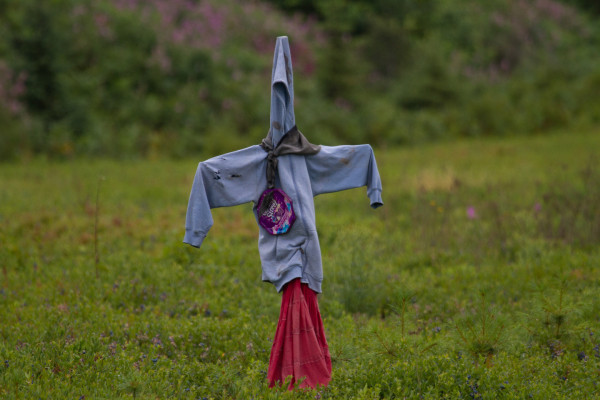
Scarecrow erected in field of blueberries on the Acadian Peninsula. Many types of scarecrow devices were used in the area including raptor kites, hanging balloons and swinging pie plates. Photo by Bryan Watts.
The whimbrels have come here to the Acadian Peninsula of New Brunswick from their distant breeding grounds around the Mackenzie Delta in the Northwest Territories by way of the Beaufort Sea. After the breeding season, they fly north to islands in the Beaufort Sea to feed and prepare for the 4,500-kilometer flight across the continent to Atlantic Canada. Here they arrive depleted and must prepare for the longest nonstop flight of their annual cycle, a 6,000-kilometer journey over the open Atlantic to winter grounds on the coast of Brazil. It will take all the fat they are able to carry to get them there. They have only three weeks to prepare.
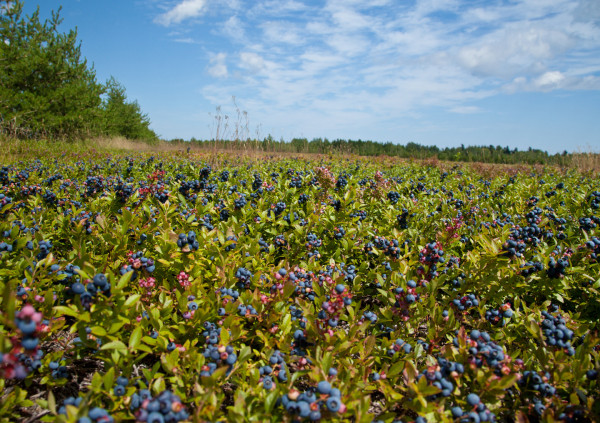
Blueberry yield on the Acadian Peninsula is tremendous varying from 2,000 to 8,000 pounds per acre. Photo by Bryan Watts.
I have come to the peninsula with Fletcher Smith from CCB to work with Julie Paquet from the Canadian Wildlife Service to quantify whimbrel use of the peninsula and to observe the interaction between whimbrels and the blueberry farmers. The population of whimbrels using the Atlantic Flyway has been declining by 4% per year since the mid-1990s. High on the list of conservation priorities is to understand how the species is faring within strategic staging areas like the Acadian Peninsula. We flew aerial surveys to determine use of blueberry fields, natural heathlands, peat mines, and barrier islands. We conducted ground surveys to quantify bird density within blueberry farms. We spent the evenings locating night roosts with Lewnanny Richardson from Nature New Brunswick (http://www.naturenb.ca/) and Kirsten Snoek, a summer student working with the Canadian Wildlife Service. And finally, we made observations of whimbrels interacting with the blueberry wardens.
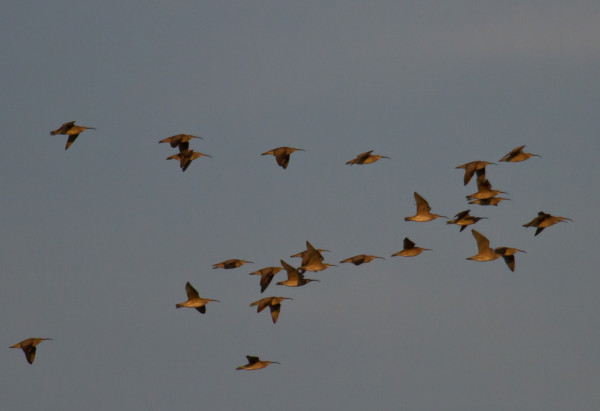
A flock of whimbrels arrives over the tree line to a blueberry field just after dawn. Photo by Bryan Watts.
During the past decade, the demand for wild lowbush blueberries has skyrocketed, producing a rush of corporations and family farmers intent on riding the blue wave. Recognized widely for their heart-healthy qualities, blueberries from the Canadian Maritimes and Maine have become a global brand. Revenues in New Brunswick alone have tripled since the early 2000s, increasing by $2.5 million per year. By 2012, the province supported 220 growers tending 33,000 acres that produced 45 million pounds of berries and revenue of $31 million. In 2013, the province produced a 5-year strategic plan that called for the development of at least another 20,000 acres of blueberries and a target production of 3000 pounds per acre. In a recent announcement, a major grower revealed a plan to invest $200 million dollars in increased blueberry production and processing capacity on the Acadian Peninsula. Currently, the two major corporate players in the region are clearing tens of thousands of acres of boreal forest to ramp up production.
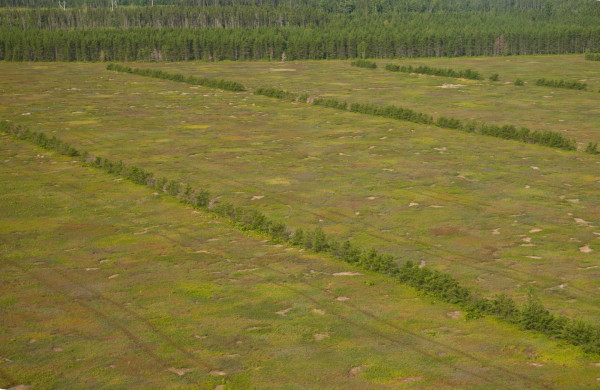
Blueberry field on the Acadian Peninsula. The lines of trees are planted for snow breaks to protect plants and to help with bee pollination. Photo by Bryan Watts.
Whimbrels have apparently come to the peninsula for thousands of years to prepare for their transoceanic flight. Accounts of shorebird hunting on Miscou Island (the northernmost point on the peninsula) from the late 1800s placed them alongside Eskimo curlew and other species feeding on blueberries and crowberries within the natural habitats. A story in The Sportsman from the 1870s describes a collection of hunting camps and blinds dotted across the heathlands.
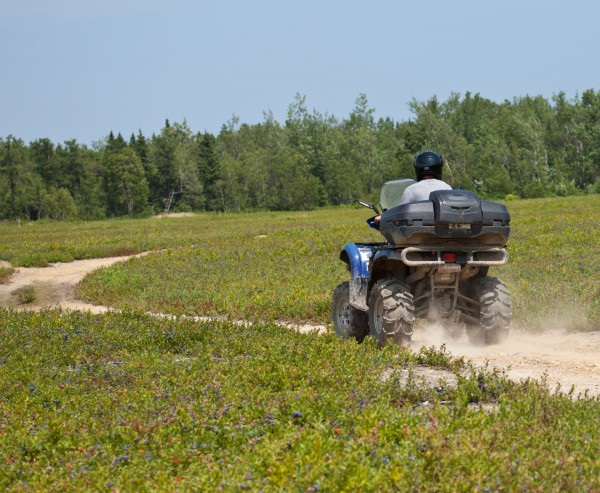
Warden patrols a blueberry field on the Acadian Peninsula on a four-wheeler. These vehicles are used extensively to access fields. Photo by Bryan Watts.
The blueberry crop is protected by a loose network of local wardens assigned to individual farms. Many wardens move campers onto the farms beginning a month before harvest. They are there to protect the berries from local rustlers and from natural consumers like whimbrel. Some of the wardens refer to the whimbrels as “Le Mangeur de Bleuets” or blueberry eater and believe that they are capable of consuming enormous quantities of berries in a single sitting. This view has made the whimbrel persona non grata on the peninsula and the target of a well-intentioned campaign to reduce crop damage. The wardens use several techniques to dissuade the birds from landing, including scarecrows of many forms, air cannons that go off on an irregular schedule, broadcast raptor calls, and guns with loads designed to scare the birds or on occasion to kill them.
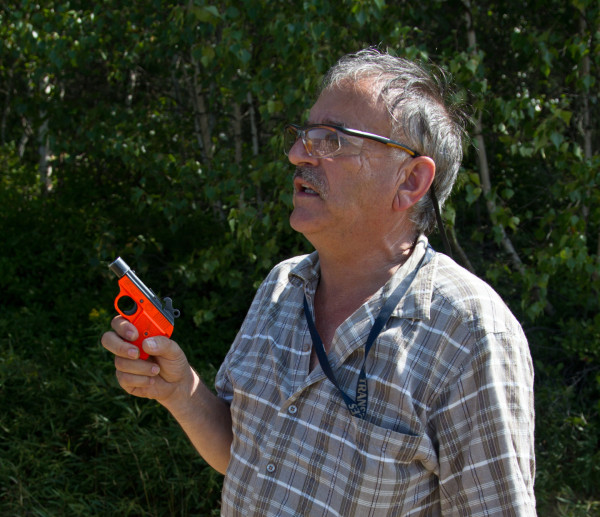
Warden with gun used for cracker and screamer shells to scare whimbrel away. Such guns are the primary approach to move birds and to train them not to return to fields. Photo by Bryan Watts.
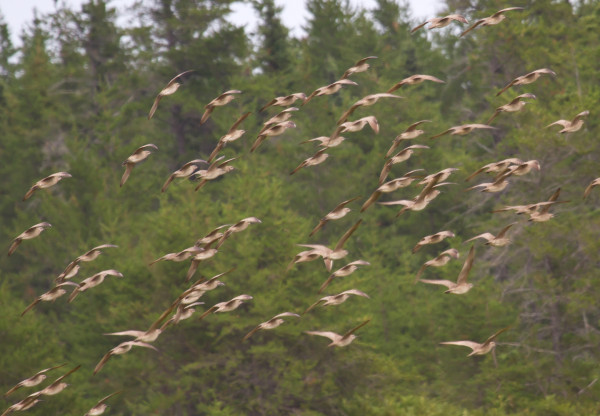
A flock of whimbrels being escorted from a berry field on the Acadian Peninsula. Photo by Bryan Watts.
The Le Mangeur de Bleuetsmay not live up to its legend. Based on metabolic requirements and blueberry nutritional values, a whimbrel would be capable of consuming a maximum of just over 1.5 pints of berries per day. Considering an average wholesale price, this consumption equates to 52 cents of product.
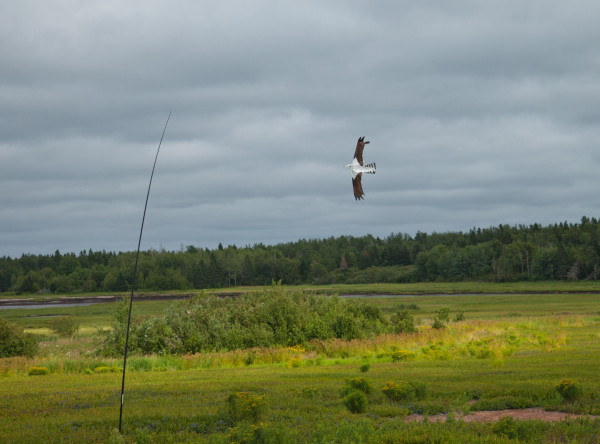
Osprey kite tethered over blueberry field. Raptor kites, flying balloons and other devices were used in the majority of blueberry fields. Photo by Bryan Watts.
The question of whimbrels or blueberries is but one example of the grand conservation question that is echoed over and over across the planet. It is embedded within the DNA of the conservation dilemma. In general terms, how much stuff is the collective “we” willing to give up in order to insure the future of other species that share the planet?. In a farm-gate crop of more than 65 million pints, are we willing to concede 0.038% to hear the calls of whimbrels approaching overhead? This August sound is just as big a part of this ancient landscape as the blueberries themselves. We continue to struggle for an answer to this basic question that calls for a tradeoff between economic return and core human values. Of course we are not just deciding for ourselves. These same birds are also welcomed in Brazil, the Gulf Coast of Texas, the Platte River in Nebraska, and the farm fields of Saskatchewan.
The irony of the present strategy is that by constantly churning up the whimbrels, the wardens are actually increasing the energy requirements of the birds and unwittingly increasing the overall blueberry consumption. In effect, by paying to disturb them, they are compounding the loss.
Written by Bryan Watts | bdwatt@wm.edu | (757) 221-2247
August 13, 2014



